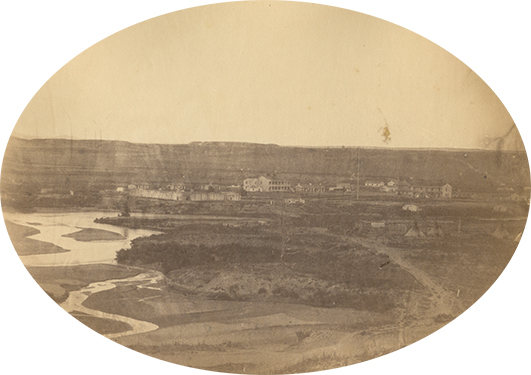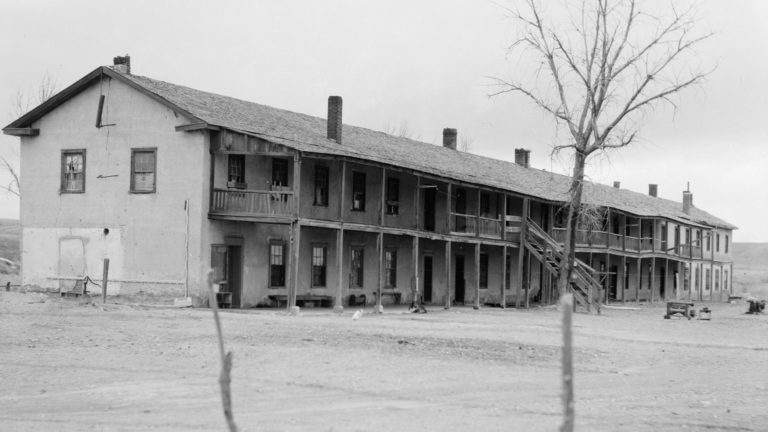An Era of Hostilities
In 1854, the relative peace along the Trail ended—apparently due to a misunderstanding or more specifically an improper and biased language translation between the Sioux and a military unit from the Fort. The Sioux called it the War of the Mormon Cow; the U.S. military called it Grattan’s Massacre.
According to several sources, a young Mormon man on a wagon train was herding a cow along the trail. It spooked and ran into a nearby camp of approximately 5,000 Minneconjou, Brule, and Oglala Sioux that had been camped in the area for several months awaiting promised government food rations. The man chased after the cow until he saw the great Indian camp.
Straight Foretop, a Minneconjou brave, waved and shouted to the Mormon to come and get his cow. The cow caused some damage to lodges and other property. However, the man left without the cow, apparently frightened— in the minds of the Sioux he left the cow to pay for damages. They killed the cow and ate it.
Upon arriving at Fort Laramie, the Mormons complained to the authorities. The next morning Brave Bear, a chief of the Brule Sioux, offered to pay for the animal in accordance with the 1851 treaty.
John Grattan, an enthusiastic young Brevet Second Lieutenant and West Point graduate, was ordered to the Sioux camp (eight miles east of Fort Laramie near present-day Lingle, Wyoming) with a complement of 28 soldiers and a hired interpreter. Grattan demanded that the cow’s killer be handed over. The interpreter reportedly added his own racial and personal insults to the Lieutenant’s demands, which further inflamed the situation. Grattan’s men opened fire on the Sioux when they refused to turn Straight Foretop over. All 29 soldiers and the interpreter were killed, along with several Sioux, including Brave Bear. Relations between the army and the Sioux immediately went from uneasy to hostile.
From this point to the mid 1860’s, some Native American bands sought out and raided wagon trains in an attempt to end the increasing stream of settlers. The army continued to provide some protection in the form of state volunteer regiments, such as the Seventh Iowa and the Eleventh Ohio, at the Fort during the American Civil War. Completion of the transcontinental telegraph line past the Fort in 1861 brought a new responsibility to the soldiers—the inspecting, defending, and repairing the “talking wire.” Troops from Fort Laramie also were involved in supplying, reinforcing, and protecting other forts along the disputed Bozeman Trail (1865 – 1868).

Conflict between the United States and the Plains Indians did not end with the Treaty of 1868 (negotiated and signed at Fort Laramie). Several major military campaigns intended to control the movements of the plains tribes began from the Fort in the early 1870s. The discovery of gold in the Black Hills in 1874, and the ensuing rush to the gold fields, violated the terms of the treaty with the Sioux (General Custer sent Scout Charley Reynolds from the Black Hills to Fort Laramie to telegraph the news of the gold discovery to the world in July of 1874).
In campaigns against the Sioux and Cheyenne, Fort Laramie served as a command post and staging area for troops pursuing Chiefs Crazy Horse, Sitting Bull, Red Cloud, and their allies who fought to retain their sacred Black Hills. The United States annexed the Black Hills into Dakota Territory in 1877.
Over the six decades of the Fort’s existence many notable visitors passed through including Jedediah Strong Smith, Thomas Fitzpatrick, James Bridger, Kit Carson, Alfred Jacob Miller, Francis Parkman, John C. Fremont, Colonel Stephen W. Kearny, Brigham Young, Father Pierre Jean De Smet, General William S. Harney, Samuel Clemens (Mark Twain), Chief Spotted Tail, Chief Red Cloud, Chief Crazy Horse, General William T. Sherman, General Phillip Sheridan, General George Crook, Martha Jane Cannary (Calamity Jane), “Colorado” Charlie Utter, James Butler Hickok (Wild Bill Hickok), Wyatt Earp, and William F. Cody (Buffalo Bill Cody).
An End, and A New Beginning
As conflicts with the Indians on the Northern Plains diminished in the 1880s, Fort Laramie’s mission evolved from offensive to administrative. In 1889, the Army recognized that Fort Laramie had served its purpose, and officially decommissioned the Fort in April of 1890. The barracks, stables and land were sold at auction.
In order to preserve the remarkable history of the site, Fort Laramie was designated as a National Monument on July 16, 1938, and a National Historic Site on April 29, 1960. Many of the Fort’s buildings and grounds have been restored to their nineteenth-century appearance.

